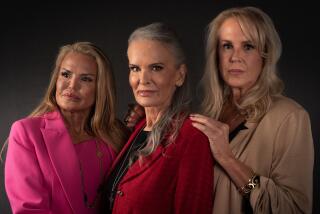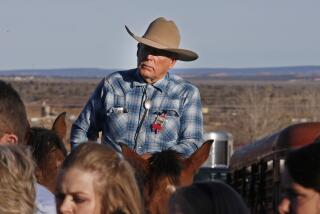Bad to the bone
- Share via
Go Down Together
The True, Untold Story
of Bonnie and Clyde
Jeff Guinn
Simon & Schuster: 468 pp., $27
Bonnie and Clyde
The Lives Behind the Legend
Paul Schneider
Henry Holt: 384 pp., $27.50
--
Within minutes of Bonnie Parker and Clyde Barrow’s deaths from police gunfire in 1934, gawkers drawn by the sound of shots surrounded their bullet-riddled Ford and snatched gory souvenirs. Someone snipped a lock of Bonnie’s hair and a piece of her bloodstained dress; a man tried to cut off Clyde’s ear. Thousands overran the Dallas funeral homes where their bodies were displayed. The “Death Car” toured the country. For two short years they had been icons of outlaw glamour; their legend would outlive them by decades. The first of many books purporting to tell their “real story” was published just months after their deaths; the 1967 movie “Bonnie and Clyde,” starring Warren Beatty and Faye Dunaway, prompted a revival that continues to this day.
Ironically, the crime spree that made Bonnie and Clyde notorious across America consisted mostly of stealing cars, sticking up gas stations and mom-and-pop stores and shooting it out with the law when their careless behavior got them noticed in the small Texas towns they favored as hide-outs. The few bank jobs they pulled were usually arranged by better-organized confederates, who seldom lasted long in the Barrow gang under Clyde’s reckless, trigger-happy leadership. The period’s other well-known outlaws, Pretty Boy Floyd and John Dillinger, considered Clyde and Bonnie rank amateurs -- “a couple of kids stealing grocery money,” sneered Dillinger. So why were they so famous?
Two new books, published to coincide with the 75th anniversary of their deaths, address that question in dramatically different ways. “Clyde and Bonnie came to epitomize the edgy daydreams of the economically and socially downtrodden,” writes veteran journalist and author Jeff Guinn in “Go Down Together: The True, Untold Story of Bonnie and Clyde.” He sees the couple as an early example of celebrities created by mass media, which first glamorized them as colorful rebels “sticking it to bankers and cops,” then demonized them as kill-crazy monsters. Guinn’s solid, traditional text chronicles their lives straightforwardly, with empathy but from a historian’s distance.
Paul Schneider gets much closer to his subjects in “Bonnie and Clyde: The Lives Behind the Legend.” Noted for his novelistic approach to nonfiction in such previous works as “Brutal Journey,” Schneider takes two big risks here. He writes throughout in the present tense and tells much of the story from Clyde’s point of view in a startling second-person narrative: “You’re just shooting the trees to pieces over the guard’s heads with your Browning automatic rifle -- . . . God, that gun feels good. Rata rata rat.” This strategy makes Schneider’s book extraordinarily immediate, not to mention lurid. Liberally quoting from eyewitness accounts (of varying reliability, he freely acknowledges in the endnotes), he excels at conveying the grungy texture of their lives, without bothering much about the historical context that Guinn carefully provides.
The authors’ contrasting techniques are striking, since both rely on the same sources and differ little as to the facts. Both Bonnie and Clyde were born in 1910, both grew up in slums outside Dallas dreaming of better things than their minimal educations and impoverished families could provide. When they met in January 1930, he was a small-time car thief and burglar, and she was a waitress recovering from a failed marriage to another low-rent crook. They both liked pricey clothes, fancy automobiles and motion pictures. While Bonnie blithely expected that someday she would be a movie star, or maybe a renowned poet, Clyde’s plans seldom went beyond the next theft and its handful of cash.
Her self-dramatizing and his insouciance set their future course. A month after they met, Clyde was arrested, convicted on multiple counts of robbery and given a relatively lenient two-year sentence. He persuaded his adoring new girlfriend to smuggle him a gun; his escape and recapture led to a new sentence of 14 years at Eastham Prison Farm, “the filthiest hellhole in the entire corrupt Texas criminal justice system,” notes Guinn.
Clyde emerged a meaner, more bitter man, determined to die rather than go back to jail. Paroled on Feb. 2, 1932, he was stealing cars and breaking into stores by April, and now Bonnie was involved. She spent two months in jail after a botched robbery, though she was still unknown enough in 1932 to convince a Texas grand jury that she’d been kidnapped by strangers and forced to accompany them.
By then, Clyde was wanted for murder, and the Texas newspapers were having a field day with stories about the “Southwest’s will-o’-the-wisp bandit.” It wasn’t until an April 1933 gun battle in Joplin, Mo., that Bonnie became as infamous as her lover. The apartment they fled under police fire had rolls of film with the now-legendary photos of Bonnie holding Clyde at mock gunpoint and of Bonnie with her foot on a fender, pistol in her hand and cigar in her mouth.
The press picked up the photos and ran them coast to coast. They spotlighted Bonnie and Clyde as young, sexy, devil-may-care outlaws. The lip-smacking coverage, combined with the growing pile of corpses left in the couple’s wake, finally prompted coordinated pursuit by lawmen; the Joplin chief of detectives sent letters to counterparts in other states proposing that they work together. Clyde, still obsessed with his sufferings at the prison farm, guaranteed further heat with a spectacular raid on Eastham in January 1934. With five inmates on the loose and one guard dead, the Texas prison manager hired former Texas Ranger Frank Hamer to track down Bonnie and Clyde, promising to back him “no matter how long it takes.”
It was only a matter of time, and the pair knew it. They often sneaked into Dallas to see their families, though every visit put them at risk. The cocky photos that made them so recognizable were laughably at odds with their actual existence: sleeping in the woods, unable to bathe, courting capture every time they bought bandages for the wounds they dared not get a doctor to treat.
At this point, Guinn’s sober narrative turns into a grim catalog of stickups and gunfights as the law’s noose tightened, while Schneider’s eerie rendering of Clyde’s thoughts captures the aimlessness and animal desperation of lives that can end in only one way. “You’re all shot up again, with a bullet . . . that went through your car door then through both your knees and into Bonnie’s leg. There may be other bullet wounds too -- who’s counting? . . . But you’re still more than going.” Going until a posse led by Hamer gunned them down in an ambush in Gibsland, La., on May 23, 1934.
Bonnie and Clyde exert an enduring fascination, not because they were master criminals, but because they embody a refusal to accept limits and a stoic willingness to take the consequences that more cautious folks never tire of experiencing vicariously. Each of these books rings true in its own way: Guinn’s Bonnie and Clyde are symbols of Depression-era anger and the American lust for fame of any kind; Schneider’s are icons of a dark romance with guns, cars and death. Which version a reader prefers will depend on individual taste; both have considerable merit. But the most cogent summing-up of Bonnie and Clyde’s mythic appeal still belongs to Bonnie, in the clumsy, hauntingly sincere final stanza of the poem she handed her mother on her last visit:
Some day they’ll go down together;
And they’ll bury them side by side,
To a few it’ll be grief --
To the law a relief --
But it’s death for Bonnie and Clyde.
More to Read
Sign up for our Book Club newsletter
Get the latest news, events and more from the Los Angeles Times Book Club, and help us get L.A. reading and talking.
You may occasionally receive promotional content from the Los Angeles Times.






